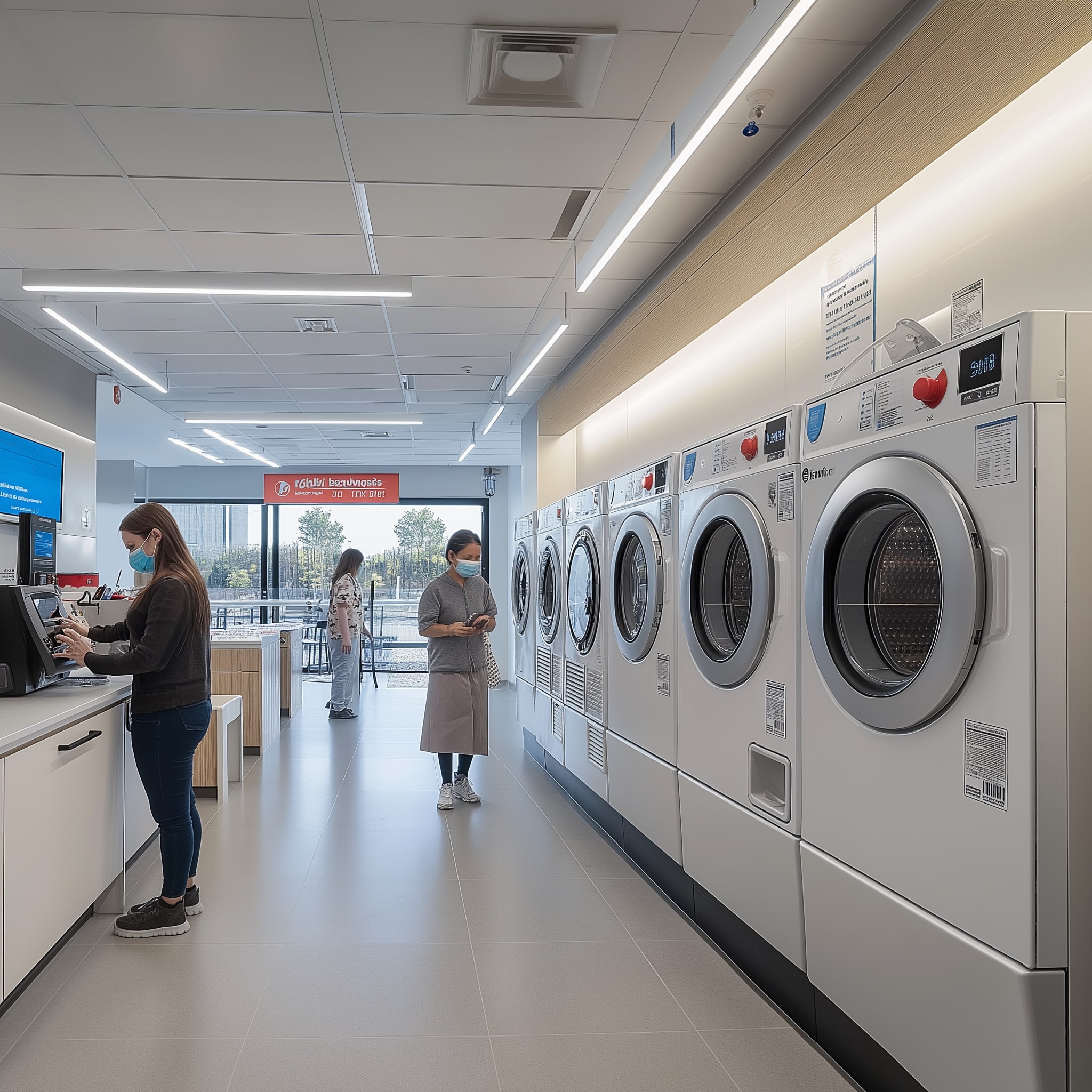The COVID-19 pandemic has significantly altered the business landscape, and laundromats were no exception. As essential services, laundromats remained open during lockdowns, but their operations underwent dramatic changes to prioritize public health and adapt to new consumer behaviors.
This article explores the long-term impacts of the pandemic on laundromat operations, including changes to cleaning protocols, shifts in customer behavior, and new business models. Understanding these developments is crucial for laundromat owners who want to thrive in the post-pandemic world.
1. Enhanced Cleaning Protocols and Sanitation Measures
Before the pandemic, standard cleaning practices were sufficient for most laundromats. However, COVID-19 heightened the importance of cleanliness, making enhanced cleaning protocols a key operational focus. As customers became more health-conscious, laundromats had to adopt stricter sanitation measures to reassure them that their facilities were safe.
a. Frequent Cleaning of High-Touch Areas
Laundromats had to implement more rigorous cleaning schedules, with special attention to high-touch areas such as:
- Washing machine and dryer handles
- Payment kiosks
- Folding tables and seating areas
- Door handles and light switches
These surfaces are now cleaned multiple times a day using disinfectants that meet the guidelines of health organizations like the CDC. Laundromats that fail to maintain these cleaning standards may see a decrease in customer confidence.
b. Air Quality and Ventilation Upgrades
COVID-19 highlighted the importance of air quality in indoor environments. Laundromats with poor ventilation were at higher risk of virus transmission, which pushed many business owners to upgrade their HVAC systems. The use of air purifiers with HEPA filters and the improvement of airflow by keeping doors or windows open during operating hours became common practices.
According to the EPA, improving ventilation can help reduce airborne contaminants, including viruses.
c. Self-Service Sanitation Stations
Many laundromats now offer self-service sanitation stations, providing customers with access to hand sanitizers, disinfectant wipes, and gloves. These stations give customers peace of mind and allow them to clean surfaces before and after use. This proactive approach helps customers feel more in control of their health and safety while using the facility.
2. Changes in Customer Behavior and Expectations
The pandemic has reshaped the way customers interact with businesses, including laundromats. Today, customers expect more convenience, safety, and transparency in the services they use.
a. Demand for Contactless Payments
COVID-19 has accelerated the shift toward cashless and contactless payments. Customers are now wary of handling coins or bills, which could harbor bacteria and viruses. To meet this demand, many laundromats have adopted digital payment systems that allow customers to pay using:
- Mobile apps like PayRange or FasCard
- Contactless credit and debit cards
- Mobile wallets such as Apple Pay and Google Pay
Offering these payment options not only enhances customer convenience but also reduces the need for physical contact, making laundromat visits safer.
b. Increased Demand for Pickup and Delivery Services
With many people avoiding public spaces during the pandemic, pickup and delivery laundry services have surged in popularity. According to PlanetLaundry, some laundromats saw a dramatic increase in demand for these services during the height of the pandemic, and the trend is continuing.
Offering delivery services appeals to a growing segment of customers who prioritize convenience and safety. Laundromat owners can use mobile apps or websites to streamline orders and logistics, ensuring smooth operations and customer satisfaction.
c. Social Distancing and Capacity Limits
Customers today are more mindful of social distancing and avoiding crowded spaces. To accommodate this, many laundromats implemented capacity limits and spaced out machines to reduce crowding. Even post-pandemic, many customers expect these measures to remain in place, as they prefer a more spacious and organized environment.
3. Changes to Business Models and Services
The pandemic forced laundromat owners to reconsider their traditional business models. In response, many introduced new services and adopted modern technologies to ensure their businesses remained profitable and met customer demands.
a. Embracing Digital Transformation
Laundromats have traditionally relied on cash payments and in-person interactions. However, the pandemic accelerated the industry’s digital transformation. Many laundromats now offer:
- Online reservations: Customers can reserve machines online to avoid waiting in-store.
- Real-time machine availability tracking: Through apps, customers can see when machines are free, reducing time spent at the laundromat.
- Automated notifications: Apps like LaundryLux’s Cents notify customers when their laundry cycles are complete, improving efficiency and customer convenience.
b. Expanding Value-Added Services
In addition to pickup and delivery services, laundromats are expanding their range of value-added services to attract and retain customers. Some of the services introduced during the pandemic include:
- Wash-and-fold services: For customers who prefer not to spend time in-store, this service has gained popularity.
- Sanitization services: Laundromats now offer laundry sanitization options, which use specialized detergents and processes to kill bacteria and viruses. These services appeal to health-conscious customers and those with vulnerable family members.
c. Offering Subscription-Based Laundry Plans
To ensure steady income streams during uncertain times, some laundromats have introduced subscription-based laundry plans. These plans offer customers a set number of washes or a specific service package each month for a flat fee. Not only does this provide predictable revenue, but it also encourages customer loyalty by simplifying laundry services.
4. Ensuring Customer Safety and Building Trust
Trust is a critical factor in attracting and retaining customers in a post-pandemic world. Laundromat owners must go above and beyond to demonstrate their commitment to health and safety.
a. Clear Communication of Safety Measures
Customers want to know that the businesses they frequent are taking safety seriously. Laundromat owners can build trust by clearly communicating their safety protocols through various channels:
- Posting signs in-store about cleaning procedures
- Updating websites with information about COVID-19 safety measures
- Using social media to reassure customers that their health is a top priority
Transparent communication helps customers feel more comfortable and confident in their decision to use your services.
b. Encouraging Customer Feedback and Online Reviews
Actively seeking customer feedback and encouraging reviews on platforms like Google My Business and Yelp can help laundromats build a positive reputation. Positive reviews about cleanliness and safety measures can set your laundromat apart from competitors and reassure potential customers.
5. Preparing for Future Health Crises
COVID-19 has highlighted the need for businesses to be prepared for potential future health crises. While the pandemic may have subsided, it’s essential for laundromat owners to be ready for similar challenges in the future.
a. Developing a Pandemic-Response Plan
Laundromat owners should develop a pandemic-response plan that outlines how they will handle future health emergencies. This plan should include:
- Enhanced cleaning protocols
- Contactless service options
- Capacity management to maintain social distancing
- Communication strategies for keeping customers informed about safety measures
Having a clear plan in place will enable laundromats to respond quickly and effectively in the event of another outbreak.
b. Investing in Technology and Automation
The laundromats that fared the best during the pandemic were those that had already invested in technology and automation. Moving forward, laundromats should continue to invest in digital solutions that allow them to operate efficiently with minimal in-person interaction. This includes:
- Self-service kiosks for payments
- Online appointment systems for machine reservations
- Automated inventory management for vending machines and detergent supplies
These technologies not only improve operational efficiency but also enhance the customer experience.
Conclusion
The COVID-19 pandemic has permanently transformed laundromat operations. Enhanced cleaning protocols, shifts in customer expectations, and the adoption of new technologies have redefined the way laundromats function. As laundromat owners look to the future, it’s essential to embrace these changes to ensure continued success in a post-pandemic world.
By focusing on digital transformation, customer safety, and expanded service offerings, laundromats can not only survive but thrive in this new landscape.


















